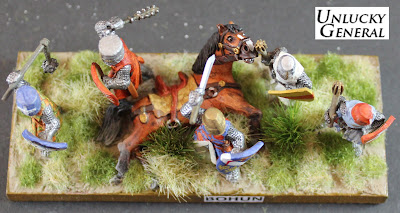Quest for Accuracy: Curse of the Pedant
I suppose the poser here is what's wrong with this image? The short answer is nothing of course. The above image is taken from L'Estoire del Saint Graal & L'Estoire de Merlin (Bibliothèque nationale de France MS Français 95, c.1280-1290) but this is the rub ... for me. This is the earliest depiction to my understanding of the oft named 'sugerloaf helm' and the earliest date for this illustration as my insert states is 1280. Up to this time, all effigies, illustrations or finds for that matter (precious few) depict the great helm as an essentially flat-topped affair.
The above seal of John deMontfort dates from 1270 and clearly shows the flat-topped great helm which is incidentally paralleled by all other surviving and datable evidence up to the abovementioned sugerloaf appearance by 1280. Whilst most followers of this blog are no doubt conversant with developments of arms and armour throughout the medieval period, I have been reminded recently of the constant development in military technology and the fact that such development never rests. The thirteenth century is no exception and this presents some traps for the wargamer - or perhaps more precisely the army builder.
I am not going to attempt an amateurish rehash of the great helm and its development but suffice to say the great helm as a replacement of the face-guard or earlier form of great helm appears to have been complete by 1250. So, by 1264 at Lewes any and all barons, knights, squires or sergeants should be modelled wearing at least an arming cap, carvelliere, pot helm, 'kettle' helm, mail coif or flat-topped great helm. There are depictions of some great helms with a slight conical top. As the sugerloaf doesn't come into effect until 1280 at the earliest, they are out for the Second Baron's War. I wish I had paid more attention to this detail previously.
Figure manufacturers don't help with labeling and packaging for the historical pedant. Using the broadest possible tags, they market their goods in a way best aimed at sales - naturally. This presents a potential pit-fall to a collector who fails to pay sufficient attention to the small details - as I have done. Anyone glancing back at my older posts will see several examples of out-of-period conical or sugerloaf helms which are now due a renovation. I am hoping judicial application of a file and a touch-up with the paintbrush will rectify this glaring oversight. I surely can't ignore it now. So, my journey continues. Thankfully this will not affect my current unit of thirty spear under the command of John Fitz John which is coming along nicely thanks to a bit of leave.
The above seal of John deMontfort dates from 1270 and clearly shows the flat-topped great helm which is incidentally paralleled by all other surviving and datable evidence up to the abovementioned sugerloaf appearance by 1280. Whilst most followers of this blog are no doubt conversant with developments of arms and armour throughout the medieval period, I have been reminded recently of the constant development in military technology and the fact that such development never rests. The thirteenth century is no exception and this presents some traps for the wargamer - or perhaps more precisely the army builder.
I am not going to attempt an amateurish rehash of the great helm and its development but suffice to say the great helm as a replacement of the face-guard or earlier form of great helm appears to have been complete by 1250. So, by 1264 at Lewes any and all barons, knights, squires or sergeants should be modelled wearing at least an arming cap, carvelliere, pot helm, 'kettle' helm, mail coif or flat-topped great helm. There are depictions of some great helms with a slight conical top. As the sugerloaf doesn't come into effect until 1280 at the earliest, they are out for the Second Baron's War. I wish I had paid more attention to this detail previously.
Figure manufacturers don't help with labeling and packaging for the historical pedant. Using the broadest possible tags, they market their goods in a way best aimed at sales - naturally. This presents a potential pit-fall to a collector who fails to pay sufficient attention to the small details - as I have done. Anyone glancing back at my older posts will see several examples of out-of-period conical or sugerloaf helms which are now due a renovation. I am hoping judicial application of a file and a touch-up with the paintbrush will rectify this glaring oversight. I surely can't ignore it now. So, my journey continues. Thankfully this will not affect my current unit of thirty spear under the command of John Fitz John which is coming along nicely thanks to a bit of leave.





Comments